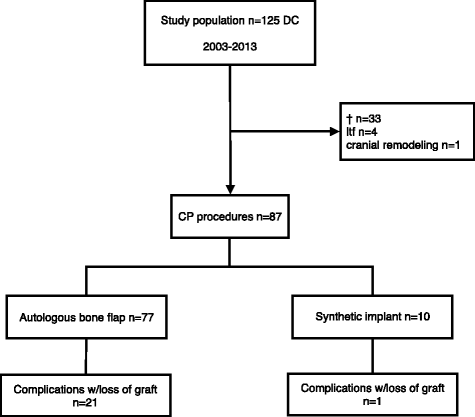Cranioplasty complications and risk factors associated with bone flap resorption
- PMID: 26437934
- PMCID: PMC4595108
- DOI: 10.1186/s13049-015-0155-6
Cranioplasty complications and risk factors associated with bone flap resorption
Abstract
Background: Decompressive craniectomy (DC) may be performed in patients with acutely raised intracranial pressure due to traumatic brain injury or stroke. It is later followed by a cranioplasty procedure (CP) in the surviving patients. This procedure is associated with a high frequency of post-operative complications. Identifying risk factors for these adverse events is important in order to improve the clinical outcome. This study examines possible predictive parameters for post-operative complications in CP.
Methods: Retrospective, single institution review of all patients undergoing a DC for acutely raised intracranial pressure over a 10 year period at Oslo University Hospital Ullevål, Norway. Subsequent CP using autologous bone flaps or synthetic implants were registered along with all post-operative complications. Predictors of post-operative complications were identified using uni -and multivariable regression analyses.
Results: A DC was carried out in 125 patients, of whom 33 died, 4 were lost to follow-up, and 1 (an infant) later underwent cranial remodeling. A CP was performed in the remaining 87 patients. Post-operative complications were recorded in 31 (36 %) patients of whom 22 lost their primary implant. Surgical site infection (SSI) and bone flap resorption (BFR) were the two most common complications, affecting 8 (9.2 %) and 14 (19.7 %) patients, respectively. Only BFR was associated with some of the recorded variables. Using multivariable logistic regression analysis, young age (OR = 0.94, 95 % CI 0.88-1.00, p = 0.04), bone flap fragmentation (OR = 14.3, 95 % CI 2.26-89, p = 0.005), long storage time (OR = 1.03, 95 % CI 1.00-1.04, p = 0.02) and Glasgow Outcome Scale at the time of cranioplasty (OR = 2.55, 95 % CI 1.04-6.23, p = 0.04) were found to be significant risk factors for bone flap resorption.
Conclusions: Cranioplasty after decompressive craniectomy carries a high rate of complications. In this study, SSI and BFR were the two most common complications of which predictive clinical parameters could be identified for BFR only. The results indicate that synthetic implants may be considered in pediatric patients and in cases with fragmented bone flaps or delayed time to cranioplasty. Although the rate of complications was high, 73 % had a successful reinsertion of the autologous graft at a low cost. We feel this result justifies the continued use of cryopreserved bone flaps.
Figures
References
-
- Vahedi K, Vicaut E, Mateo J, Kurtz A, Orabi M, Guichard J-P, et al. Sequential-design, multicenter, randomized, controlled trial of early decompressive craniectomy in malignant middle cerebral artery infarction (DECIMAL Trial) Stroke. 2007;38:2506–2517. doi: 10.1161/STROKEAHA.107.485235. - DOI - PubMed
-
- Martin KD, Franz B, Kirsch M, Polanski W, von der Hagen M, Schackert G, et al. Autologous bone flap cranioplasty following decompressive craniectomy is combined with a high complication rate in pediatric traumatic brain injury patients. Acta Neurochir (Wien) 2014;156:813–824. doi: 10.1007/s00701-014-2021-0. - DOI - PubMed
MeSH terms
LinkOut - more resources
Full Text Sources
Other Literature Sources
Medical
Miscellaneous


